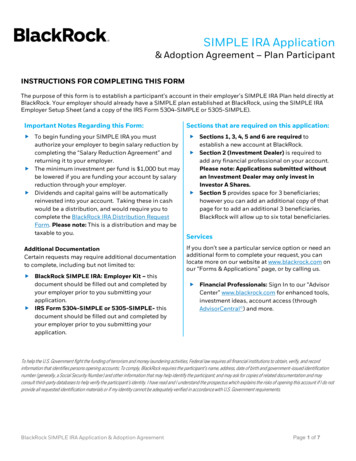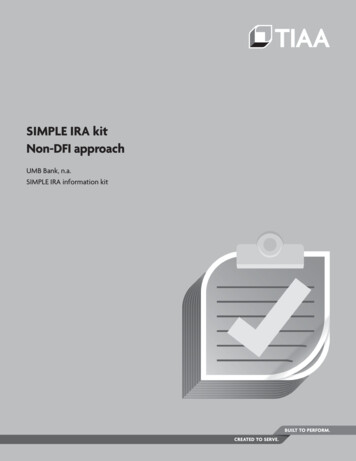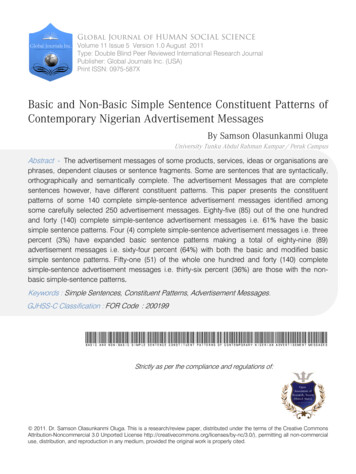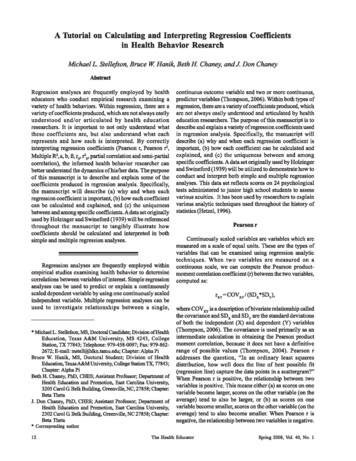
Transcription
How to create a simple ColdFire and Altera FPGA IOC (Draft)W. Eric NorumSeptember 28, 2005
Contents1Introduction12FPGA application33EPICS application114Remote Reset15A ledDeviceSupport.c17B Alternate Pinouts21i
Chapter 1IntroductionThis tutorial presents a step-by-step series of operations for creating a simple EPICS application for an ArcturusuCDIMM ColdFire 5282 module attached to an Altera FPGA development kit. The following software and hardwarecomponents are assumed to be in place: Arcturus uCDIMM ColdFire 5282 RTEMS with m68k tool chain and uC5282 board-support package EPICS version R3.14.7 or greater with RTEMS-uC5282 target Altera FPGA development kit with at least two sets of expansion prototype connectors. ColdFire/Stratix adapter card Quartus version 5.0 or greater and Altera SOPC builder ColdFire bridge SOPC component Console reset detect Quartus component (optional)This tutorial is written for use with an Altera Stratix II DSP development kit. The changes required for use with otherdevelopment kits are summarized in appendix B.1
CHAPTER 1. INTRODUCTION2
Chapter 2FPGA application1. Use the Quartus ”New Project Wizard” to create a new project. I called the project IOC Example with samename for the top-level entity:2. Ensure that unused pins are treated as inputs (Assignments Device. . . , Device & Pin Options, Unused Pinstab). Not all the ColdFire signals are used by this example and Quartus helpfully grounds all the corresponding3
CHAPTER 2. FPGA APPLICATIONpins if this step is omitted!3. Start the SOPC Builder (Tools SOPC Builder. . . ) and create a new SOPC system. I called the SOPC systemIOC ExampleSystem:4. Set the SOPC Board and Clock parameters:4
CHAPTER 2. FPGA APPLICATION5. If you have not done so in a previous SOPC project, add the directory containing the ColdFire Bridge SOPCcomponent to the list of directories which the SOPC Builder will search (File SOPC Builder Setup. . . ). Notethat this list of directories applies to SOPC Builder sessions in all projects. Note also that changes to this listdo not take effect until the SOPC Builder is next started. When the SOPC Builder is started and searches thedirectory containing the ColdFire Bridge SOPC component it will add the ColdFire Bridge component to thelist of User Logic components.6. Double-click the ColdFire Bridge component to add it to the SOPC design:5
CHAPTER 2. FPGA APPLICATION7. Add an 8-bit output port to the SOPC design:The SOPC components and connections should then be:8. Click the Generate button to create the SOPC block.9. Create the top-level entity design file. In the Quartus window select File New, create a new Block Diagram/Schematic File and save it as IOC Example.10. Double-click in the IOC Example.bdf design window and add the IOC ExampleSystem SOPC blockto the design:6
CHAPTER 2. FPGA APPLICATION11. Add I/O pins and assign them to the appropriate FPGA pins using the Assignment Editor. A list of the pinassignments for several different development kits is included in appendix B. The complete system should thenappear as shown on the following page.12. Make some changes to some settings (Assignments Settings. . . ):User Libraries (Current Project) Add the path to the directory containing the ColdFire Bridge SOPC component:Files Quartus II has a bug which causes it to generate a bad system unless the ColdFireBridge.bdf designfile is explicitly mentioned in the list of application files:7
CHAPTER 2. FPGA APPLICATION13. Compile the project (you’ll see lots of warnings. . . ) and load it into the FPGA.8
CHAPTER 2. FPGA APPLICATION9
CHAPTER 2. FPGA APPLICATION10
Chapter 3EPICS applicationThe steps listed below show how to create an example EPICS IOC application which uses the ASYN I/O environmentto control the LEDs on the FPGA card.1. Create a new EPICS TOP directory and make a new application in it. You must specify the full path to themakeBaseApp.pl script in your EPICS installation:/· · ·/makeBaseApp.pl -t ioc ledDriver/· · ·/makeBaseApp.pl -t ioc -i -a RTEMS-uC5282 ledDriver2. Edit configure/CONFIG to enable only the RTEMS-uC5282 target:CROSS COMPILER TARGET ARCHS RTEMS-uC52823. Edit configure/RELEASE to specify the location of ASYN support:ASYN /· · ·/modules/soft/asyn4. Edit ledDriverApp/src/Makefile: Build only for RTEMS IOC targets (change the PROD IOC line to PROD RTEMS):PROD RTEMS ledDriver Add asyn support:ledDriver DBD asyn.dbd Add the asyn library to ledDriver LIBS (before the EPICS BASE IOC LIBS line which is alreadythere):ledDriver LIBS asynledDriver LIBS (EPICS BASE IOC LIBS) Add the FPGA device support dbd file (to be written in a following step):ledDriver DBD ledDeviceSupport.dbd Add the FPGA device support source file (to be written in a following step):ledDriver SRCS ledDeviceSupport.c5. Edit ledDriverApp/Db/Makefile and add the line:11
CHAPTER 3. EPICS APPLICATIONDB ledDriver.db6. Create the ledDriverApp/Db/ledDriver.db file referred to in the previous step. The file should contain:record(longout,"leds") {field(DTYP,"asynInt32")field(OUT,"@asyn(ledDriver 0 0)")}The three values in the OUT field are:(a) The port name.(b) The address (unused by this driver, but still needed)(c) The timeout value, in seconds (unused by this driver, but still needed).7. Create ledDriverApp/src/ledDeviceSupport.dbd with the )8. Create ledDriverApp/src/ledDeviceSupport.c. A complete listing of is included in appendix A. Much of this fileis common to all ASYN drivers. The following points describe the lines of particular interest to this application.12 When the SOPC Builder generates a system it creates a C header file describing the system components.This header file can be included explicitly or, as I have done, can be symbolically linked to a file in theapplication source directory:ln -s ./././FPGA/coldfirebridge 0 map/system.h ledDriverApp/src/SOPC.h14 The SOPC address space appears in the ColdFire address space at the locations mapped to CS1 and CS2.The RTEMS board-support package sets up these chip selects at locations 3000000016 and 3100000016 ,respectively.15 The ’ 1’ is required because the ColdFire bus is 16-bit big-endian so the least-significant byte on the databus appears at an odd address.23 The table of asynInt32 methods can’t be statically initialized (like the asynCommon methods are at line 55)since the asynInt32Base initialize method (invoked at line 99) writes to the table to override some methods.41 The check for the existence of the I/O port turns off all of the LEDs. A real application might want to dosomething different.65 The line of code that actually performs the I/O operation.72 More complete device support would probably do nothing more in this routine than register an iocsh command. The actual ASYN registration calls would then be called from this command when invoked by thest.cmd script. This would allow the port name to be set from the st.cmd script rather than being burnedinto the program.80 The arguments to the registerPort method are:(a)(b)(c)(d)(e)The port name.The port attributes. This driver is is not ’multi device’ and does not block.The autoconnect flag. This driver wants to be automatically reconnected.The priority of the I/O thread (unused for this driver).The stack size of the I/O thread (unused for this driver).9. Run make to compile the application.12
CHAPTER 3. EPICS APPLICATION10. Use the uCDIMM ColdFire 5282 setenv command to set environment variables as shown below. The exactvalues will differ as appropriate for your network numbers and NFS server:B setenv IPADDR0 www.xxx.yyy.56B setenv HOSTNAME ioccoldfire2B setenv BOOTFILE ucdimm.bootB setenv NAMESERVER www.xxx.yyy.167B setenv NETMASK 255.255.252.0B setenv SERVER www.xxx.yyy.167B setenv NFSMOUNT nfsserver:/export/homes:/homeB setenv CMDLINE /· · ·/FPGA IOC Example/EPICS/iocBoot/iocledDriver/st.cmdB printenvFACTORY Arcturus Networks Inc.REVISION uC5282 Rev 1.0 4MB External FlashSERIAL X42B20ADC-0130CCONSOLE ttyS0KERNEL 0:linux.binKERNEL ARGS root /dev/rom0HWADDR0 00:06:3B:00:53:0CFW VERSION 1800010 10000000:400000:RWRAMIMAGE yesIPADDR0 www.xxx.yyy.56CACHE onHOSTNAME ioccoldfire2BOOTFILE ucdimm.bootNAMESERVER www.xxx.yyy.167NETMASK 255.255.252.0SERVER www.xxx.yyy.167NFSMOUNT nfssrv:/export/homes:/homeCMDLINE ./FPGA IOC Example/EPICS/iocBoot/iocledDriver/st.cmd11. Download and execute the application: Start the TFTP server on the ColdFire:B tftpuCTFTP Console 1.0 is running . Use the tftp program on your workstation to transfer the executable image to the ColdFire:tftp binarytftp connect www.xxx.yyy.56tftp put ledDriver.boot When the executable image has been transferred press the ESC key to the ColdFire to terminate theTFTP server. Use the goram command to start the IOC:Downloading.B goramGo from RAM!Go from 0x40000NTPSERVER environment variable missing -- using www.xxx.yyy.167***** Initializing network *****13
CHAPTER 3. EPICS APPLICATIONStartup after External reset.fs1: Ethernet address: 00:06:3b:00:53:0c***** Initializing NFS *****This is RTEMS-RPCIOD Release Name: ( Id: tutorial.tex,v 1.13 2005/09/28 22:11:06 norume Exp )Till Straumann, Stanford/SLAC/SSRL 2002See LICENSE file for licensing infoThis is RTEMS-NFS Name: ( Id: tutorial.tex,v 1.13 2005/09/28 22:11:06 norume Exp )Till Straumann, Stanford/SLAC/SSRL 2002See LICENSE file for licensing infoTrying to mount www.xxx.yyy.167:/export/homes on /home***** Initializing NTP ********** Starting EPICS application *****## Example RTEMS startup script## You may have to change ledDriver to something else## everywhere it appears in this file# envPaths## Register all support ,0)ledDriver registerRecordDeviceDriver(pdbbase)## Load record instancesdbLoadRecords("././db/ledDriver.db","user norume")iocInit()Starting #################################### EPICS IOC CORE built on Jul 25 2005### EPICS R3.14.7 Name: Date: 2005/09/28 22:11:06 ##########################iocInit: All initialization complete## Start any sequence programs#seq sncledDriver,"user norume"ioccoldfire2 14
Chapter 4Remote ResetAll VME IOCs at the APS have a card which monitors the console received-data line and generates a system reset whena particular sequence (three consecutive control-X, control-Y or control-Z characters or any consecutive combinationsof these characters) of characters is detected. It is quite easy to add this capability to the ColdFire/FPGA IOC.1. Make a special serial line cable which will connect the serial received-data and ground lines of the ColdFireconsole port to the 9-pin connector on the FPGA development kit. The following picture shows an example.The 9-pin connector plugged in to the FPGA development kit has only two pins (received-data and ground).2. Add the path to the directory containing the Console Reset Detect component to the list of application userlibraries:15
CHAPTER 4. REMOTE RESET3. Add the following components to the application top-level entity (IOC Example.bdf). The ConsoleResetBaudDivider is a simple modulus-651 counter which sets the serial line speed at 9600 baud (100000000 (9600 16) 651). If you’re using a different system clock or a different serial line speed you’ll have toreplace this component with your own counter.4. Recompile the project and load it into the FPGA. You should now have the ability to remotely reset the ColdFire.16
Appendix 21222324252627282930313233343536/** ASYN Int32 driver for simple FPGA application*/#include epicsStdio.h #include epicsExport.h #include cantProceed.h #include asynDriver.h #include asynInt32.h #include devLib.h #include "SOPC.h"/* Symbolic link to SOPC-generated system header file */#define AVALON BASE 0x30000000/* Base of Avalon space in ColdFire space */#define OPTR ((epicsUInt8 *)(AVALON BASE PIO 0 BASE 1))/** Driver private storage*/typedef struct drvPvt {asynInterface common;asynInterface asynInt32;asynInt32asynInt32Methods;volatile epicsUInt8 *optr;} drvPvt;/** asynCommon methods*/static voidreport(void *pvt, FILE *fp, int details){}static asynStatusconnect(void *pvt, asynUser *pasynUser)17
APPENDIX A. 78798081828384858687{drvPvt *pdrvPvt (drvPvt *)pvt;epicsUInt8 dummy 0;if (devWriteProbe(sizeof(dummy), pdrvPvt- optr, &dummy) ! 0) {asynPrint(pasynUser, ASYN TRACE ERROR, "ledDriver: memory probe failed\n");return asynError;}pasynManager- exceptionConnect(pasynUser);return asynSuccess;}static asynStatusdisconnect(void *pvt, asynUser *pasynUser){pasynManager- exceptionDisconnect(pasynUser);return asynSuccess;}static asynCommon common { report, connect, disconnect };/** asynInt32 methods*/static asynStatusint32Write(void *pvt, asynUser *pasynUser, epicsInt32 value){drvPvt *pdrvPvt (drvPvt *)pvt;*pdrvPvt- optr value;return asynSuccess;}/** Register ourself with ASYN*/static void ledDriverDeviceSupportRegistrar(void){drvPvt *pdrvPvt;asynStatus status;const char *portName "ledDriver";pdrvPvt callocMustSucceed(sizeof(drvPvt), 1, "ledDriver");status pasynManager- registerPort(portName, 0, 1, 0, 0);if(status ! asynSuccess) {printf("ledDriver registerDriver failed\n");return;}pdrvPvt- common.interfaceType asynCommonType;pdrvPvt- common.pinterface (void *)&common;18
APPENDIX A. 2103104105106pdrvPvt- common.drvPvt pdrvPvt;status pasynManager- registerInterface(portName, &pdrvPvt- common);if (status ! asynSuccess) {printf("ledDriver registerInterface failed\n");return;}pdrvPvt- asynInt32Methods.write int32Write;pdrvPvt- asynInt32.interfaceType asynInt32Type;pdrvPvt- asynInt32.pinterface &pdrvPvt- asynInt32Methods;pdrvPvt- asynInt32.drvPvt pdrvPvt;status pasynInt32Base- initialize(portName, &pdrvPvt- asynInt32);if (status ! asynSuccess) {printf("ledDriver pasynInt32Base- initialize failed\n");return;}pdrvPvt- optr egistrar);19
APPENDIX A. LEDDEVICESUPPORT.C20
Appendix BAlternate PinoutsThe information in this tutorial applies to several Altera development kits, including:1. Stratix II DSP development kit(EP2S60), 100 MHz clock.2. Stratix II NIOS development kit (EP2S60), ”BoardClock100” input is a 50 MHz clock.3. Cyclone II NIOS development kit (EP2C35), ”BoardClock100” input is a 50 MHz clock, expansion prototypeconnectors require extensions to clear tall components on development kit.The pin assignments for each of these kits are presented in the following 6N18P18G23G24G25G26H23H24J23J24H25H26K18K19K23
APPENDIX B. ALTERNATE B151. Pin AE24 on the Cyclone II kit is a dual-purpose pin and needs to be configured as Assignments Device. . . ,Device & Pin Options, Dual-Purpose Pins tab): Change nCEO from ”Use as programming pin” to ”Use asregular IO”.22
This tutorial presents a step-by-step series of operations for creating a simple EPICS application for an Arcturus uCDIMM ColdFire 5282 module attached to an Altera FPGA development kit. The following software and hardware . Altera FPGA development kit with at least two sets of expansion prototype connectors.











